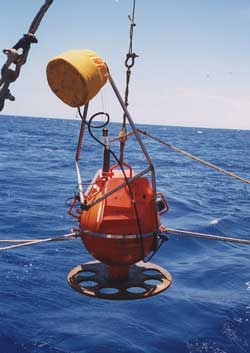
|
The Ocean Bottom Seismometer is a self contained data-acquisition system which free falls to the ocean floor and records seismic data generated by airguns and earthquakes. The Ocean Bottom Seismometer facility provides technical support for a variety of scientific investigations ranging from deep crustal structure to gas hydrate and surface sediments. The facility serves the entire U.S. Geological Survey as well as academic institutions. We currently operate 12 Ocean Bottom Seismometers. The Ocean Bottom Seismometers are portable, self contained, inexpensive to operate, and can be deployed and retrieved off almost any size boat (including a Zodiac). They are therefore, uniquely suitable to record wide-angle reflection and refraction shots in remote areas or under primitive conditions and to be deployed on short notice to record earthquake aftershocks.
|
|
As of 2002, the USGS has entered an agreement with the national OBS facility at the Woods Hole Oceanographic Institution to build and maintain 16 short-period OBS within the facility. Five of these OBS and a modest amounts of funding are available for USGS and non-USGS investigators to be deployed in repsonse to an earthquake or volcanic activity in the coastal ocean and its vicinity. For further information refer to the Policy for Rapid Mobilization of USGS OBS (RMOBS).
|
Short Period OBS (Photo courtesy of Beecher Wooding)
|
Experiments since 1990 : Chesapeake Bay EDGE (1990), the San Francisco Bay BASIX (1991), Lake Baikal Rift (1992), San Pablo Bay, California (1993), Antarctica (1994), Mendocino Triple Junction (1994), Aleutian Islands, Alaska (1994), the Los Angeles LARSE (1994), the Blake Ridge gas hydrate experiment (1995), New Zealand SIGHT (1996), the Cascadia Margin (1996), the Greenland continental margin (1996), SHIPS in Puget Sound (1998), ODP leg 179 Indian Ocean (1998), and Puerto Rico (2000).
United States Geological Survey Collaborators
-
Uri ten Brink (utenbrink@usgs.gov) - Scientist-in-charge
-
Greg Miller (gmiller@usgs.gov) - Support and Engineering
-
Ray Davis (redavis@usgs.gov) - Mechanical Engineering
|




 Woods Hole Science Center > Technology
Woods Hole Science Center > Technology